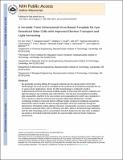Versatile Three-Dimensional Virus-Based Template for Dye-Sensitized Solar Cells with Improved Electron Transport and Light Harvesting
Author(s)
Dang, Xiangnan; Klug, Matthew Thomas; Qi, Jifa; Dorval Courchesne, Noemie-Manuelle; Burpo, Fred John; Fang, Nicholas Xuanlai; Hammond, Paula T.; Belcher, Angela M.; Chen, Po-Yen, Ph. D. Massachusetts Institute of Technology; ... Show more Show less
DownloadHammond_Versatile three.pdf (4.205Mb)
PUBLISHER_POLICY
Publisher Policy
Article is made available in accordance with the publisher's policy and may be subject to US copyright law. Please refer to the publisher's site for terms of use.
Terms of use
Metadata
Show full item recordAbstract
By genetically encoding affinity for inorganic materials into the capsid proteins of the M13 bacteriophage, the virus can act as a template for the synthesis of nanomaterial composites for use in various device applications. Herein, the M13 bacteriophage is employed to build a multifunctional and three-dimensional scaffold capable of improving both electron collection and light harvesting in dye-sensitized solar cells (DSSCs). This has been accomplished by binding gold nanoparticles (AuNPs) to the virus proteins and encapsulating the AuNP–virus complexes in TiO2 to produce a plasmon-enhanced and nanowire (NW)-based photoanode. The NW morphology exhibits an improved electron diffusion length compared to traditional nanoparticle-based DSSCs, and the AuNPs increase the light absorption of the dye-molecules through the phenomenon of localized surface plasmon resonance. Consequently, we report a virus-templated and plasmon-enhanced DSSC with an efficiency of 8.46%, which is achieved through optimizing both the NW morphology and the concentration of AuNPs loaded into the solar cells. In addition, we propose a theoretical model that predicts the experimentally observed trends of plasmon enhancement.
Date issued
2013-08Department
Massachusetts Institute of Technology. Department of Biological Engineering; Massachusetts Institute of Technology. Department of Chemical Engineering; Massachusetts Institute of Technology. Department of Materials Science and Engineering; Massachusetts Institute of Technology. Department of Mechanical Engineering; Koch Institute for Integrative Cancer Research at MITJournal
ACS Nano
Publisher
American Chemical Society (ACS)
Citation
Chen, Po-Yen, Xiangnan Dang, Matthew T. Klug, Jifa Qi, Noémie-Manuelle Dorval Courchesne, Fred J. Burpo, Nicholas Fang, Paula T. Hammond, and Angela M. Belcher. “Versatile Three-Dimensional Virus-Based Template for Dye-Sensitized Solar Cells with Improved Electron Transport and Light Harvesting.” ACS Nano 7, no. 8 (August 27, 2013): 6563–6574.© 2013 American Chemical Society.
Version: Author's final manuscript
ISSN
1936-0851
1936-086X